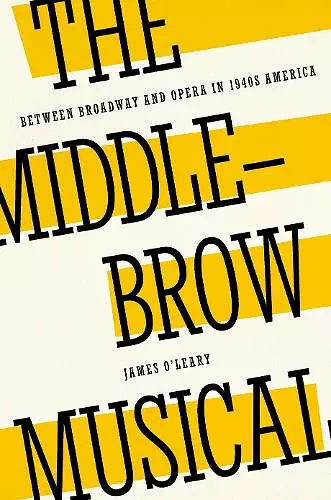The Middlebrow Musical
Between Broadway and Opera in 1940s America
Format:Hardback
Publisher:Oxford University Press Inc
Published:30th Sep '25
Should be back in stock very soon

Rattled by two world wars, ongoing discrimination, and economic calamity, a group of critics in 1940s New York sought to promote art that would do nothing less than heal the world. The primary obstacle to this project, they believed, was that American culture had splintered into factions, which in turn divided American audiences: highbrow art, which these writers regarded as obscure and elitist; folk art, which they found provincial and alienating; and popular culture, which they considered merely commercial. Blending these kinds of art, they argued, could draw together a fractured society into mutual understanding (if not necessarily agreement) by situating the most sophisticated ideas within longstanding expressive traditions, accessible to all. Their contemporaries called this culture “middlebrow” and believed that its culmination appeared on Broadway. The Middlebrow Musical straddles the study of popular musical theater and opera, and in so doing charts a new path through modernism. Through detailed archival work, this book uncovers the crucial critical networks that originally theorized a middlebrow approach to culture, beginning in the literary circles of Van Wyck Brooks and Archibald MacLeish, and radiating outward to major theater and music critics including Brooks Atkinson and Olin Downes. Their broad influence on theater becomes clear as this book follows three shows from their earliest conceptions to their opening-night reviews: Richard Rodgers's and Oscar Hammerstein II's Oklahoma!, Duke Ellington's and John Latouche's Beggar's Holiday, and Kurt Weill's, Elmer Rice's, and Langston Hughes's Street Scene. Each chapter features behind-the-scenes communications, which reveal how these Broadway writers explicitly deployed middlebrow theories to negotiate high-art aspirations toward operas, symphonies, and experimental theater; toward contemporary folk-music studies; and toward popular-culture accessibility, all with civic intentions of pulling disparate audiences together into a thoughtful reflection upon the modern, war-torn world. While The Middlebrow Musical focuses on Broadway, it also offers new strategies for understanding the relationship between popular and highbrow culture during the early decades of the twentieth century. Compared to the experiments of high modernism, many of the works featured in this book have struck previous scholars as conservative or cautious. The Middlebrow Musical invites readers to take another look, to consider the forgotten principles that inspired these works, and to recognize them as equally daring and controversial contributions to twentieth-century art.
Situating the Broadway musical of the 1940s in the context of Van Wyck Brooks's 'middlebrow modernism,' Jamie O'Leary's lively The Middlebrow Musical considers how the amalgamation of 'folk art, high art, and popular culture' in Oklahoma! reverberated in three notable musicals produced later in the decade: Beggar's Holiday, Street Scene, and Finian's Rainbow. This thoughtful and ingenious a study marks an important contribution to our understanding not only of the aesthetics of the mid-century Broadway musical but of the time's larger cultural landscape. * Howard Pollack, John and Rebecca Moores Professor of Music at the University of Houston, author of George Gershwin: His Life and Work and The Ballad of John Latouche: An American Lyricist's Life and Work. *
For returning our attention to vital matters of cultural hierarchy, O'Leary's book, like the satisfying revival of a Broadway musical, deserves a standing ovation. Its analysis of critics, composers, and lyricists-some unjustly forgotten, others so familiar that they demand fresh perspective-unsettles fixed categories, demonstrating the dynamic relationships between high art and popular expression. As he contributes a new definition of the quest for 'integration' his protagonists pursued, O'Leary himself integrates archival research and textual analysis, institutional theory and compelling evidence, while exhibiting the sensitivities of both the musicologist and the cultural historian to his subjects' democratic hopes. * Joan Shelley Rubin, Dexter Perkins Professor of History at the University of Rochester, author of The Making of Middlebrow Culture. *
Few studies of the musical conceptually reframe their subject in a way that makes you rethink what you thought you knew about it. Count The Middlebrow Musical among them. Rather than following tradition and looking inward at a moment in the genre's formal history, this study looks refreshingly outward to the history of ideas: it analyzes key musicals of the 1940s in terms of the era's social, political, and esthetic controversies as these informed not just the reception of such musicals but also the Jarger critical debates over why, how, and whether so popular a form of entertainment might now legitimately embrace a new and heightened sense of cultural purpose. * Larry Stempel, Author of Showtime: A History of the Broadway Musical Theater *
ISBN: 9780190265212
Dimensions: 237mm x 167mm x 23mm
Weight: 549g
272 pages